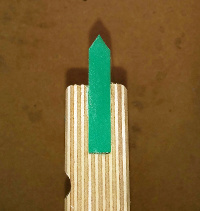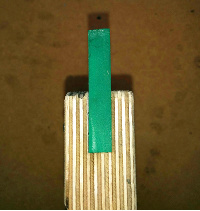Difference between revisions of "Equipment/Screenprinting"
(→Stock) |
(→Stock) |
||
| Line 126: | Line 126: | ||
* System 3 Acrylic print medium (paper/general use) | * System 3 Acrylic print medium (paper/general use) | ||
* System 3 Acrylic print medium (fabric) | * System 3 Acrylic print medium (fabric) | ||
| − | * System 3 Acrylic pigments for colour mixing: Black, white, yellow, red, blue | + | * System 3 Acrylic pigments for colour mixing: Black, white, yellow, red, blue, silver |
| − | * Permaset Aqua Fabric Magic -- print-ready (pre-mixed) fabric inks: Black | + | * Permaset Aqua Fabric Magic -- print-ready (pre-mixed) fabric inks: Black, green |
'''Cotton Shopping Bags''' | '''Cotton Shopping Bags''' | ||
Revision as of 14:05, 10 December 2015
Class Orange equipment: Only use if you are confident doing so. Training is available if not.
(More about equipment classes)
Contents
Summary
Screenprinting is a manual printing technique using liquid ink and a stencil to create permanent images on sheets of paper, card or fabric or pre-existing items such as t-shirts and cotton shopping bags. Due to the amount of work required for set-up before and clean-up after printing, the process is most suitable for printing multiple identical items in one session such as a set of t-shirts or posters.
A screen is a frame with a fine polyester mesh stretched across it which carries a stencil. The printing process applies liquid ink/paint in one colour at a time using a squeegee. The stencil on the screen-mesh works in a similar way to stencils in other art processes: some areas of the screen are left open and others are blocked. This determines where ink is deposited onto the piece and thus creates a design or image. The result is a thin film of ink applied to the workpiece.
Makespace supports waterbased screenprinting on paper, fabric and other materials up to A2 size.
Making stencils
There are many ways to create stencils, including cutting paper or sticky vinyl and also photographic emulsions. At Makespace we support vinyl and paper stencils. Vinyl stencils can be made on the vinyl cutter. Paper stencils can be cut with scissors or craft knives or on the laser cutter, if you are already trained on it.
You will probably need to try different types of stencil to work out which kind of stencil works best for your design. Factors include the level of detail in the design and whether there are any 'islands' such as the inside of a letter 'o'.
We do not currently support photographic methods at Makespace due to lack of a darkroom and lightsafe storage area. It is possible to create photographic stencils at home and bring the finished screen in to print with at Makespace. But please do not take Makespace screens away from Makespace.
Main steps in the screenprinting process
- Create a stencil and attach it to the screen (or use a screen with stencil prepared previously)
- Select or mix the appropriate ink for fabric or paper (by default a 50/50 mix of pigment/paint and print medium)
- Print things
- Clean up: Reclaim ink where possible then clean screens and tools immediately. Wash ink from hands afterwards.
- Pay for any Makespace materials used (paper and ink)
- Fabric only: Once ink has dried, heat-fix any prints using the iron or heatpress
Owners
- Jo Brook
- Matthew Taylor
Training
See owners for occasional demos.
Daler Rowney System 3 Screenprinting Demo (video)
Screenprinting with vinyl cutter stencil (instructions)
Warnings
Waterbased screenprinting does not have serious hazards as a process but without due care the ink can permanently damage various items in the space. This includes yours (or others') clothes or workpieces and also the screens themselves, inconveniencing other screenprinters by making screens unusable.
Take care when moving the larger and heavier pieces of equipment, especially if there are other people passing through the space.
Safety
- The main printbed and platen are solid and relatively heavy so take care when reversing the platen to or from t-shirt to flat-item-printing mode.
- The drawers in the plan chest are heavy and can be pulled all the way out of the chest. Be careful and pull them out slowly and not beyond around half way.
- After cleaning ink from the equipment also wash it off your hands
- Screenprinting ink will stain clothes, since it is designed to dye fabric permanently. So wear an apron while printing and pay attention to stray bits of ink, wiping hands and equipment with tissue paper if needed during the session.
- Ink is liquid so work with care not to let splashes of it get onto other people's work. This applies especially when washing the screen out as the diluted ink can still stain and is more likely to splash than when the ink is in its print thickness.
- Wash out the screen immediately after the last item has been printed. Waterbased ink starts drying into the screen as soon as you are not actively printing to force new ink through the mesh. Prompt washout will help remove as much ink as possible which will help shared screens to be ready for the next user.
House Rules
The facilities are shared and the printing area is small and located in a busy area. So there are some house rules for using this equipment.
Ink / paint
- Makespace supports waterbased printing only, whether you are using Makespace shared equipment or some of your own.
So, as a guide, do not use any inks, paints or varnishes which cannot be removed from the screen using just water and washing up liquid. (Non-waterbased printing is offered by some of the specialist printmaking studios in Cambridge.)
- You may bring in and use your own ink if it is waterbased. If it is not one of the inks already in stock, check the procedure for bringing chemical products into Makespace: Hazardous_Materials. Most suitable inks will be the ones which don't have hazard warnings. If in doubt about ink, ask the owners or on the forum before using it in Makespace.
Screens
Makespace has a small number of shared screens which are intended for short-term use and learning.
As they are shared this means that:
- No permanent stencils should be applied to screens. These are only usually needed for print runs in the 1000s of items.
- You should aim to finish your printing in one session if possible and remove the stencil at the end of the session.
- For large print runs and longer-term use, we recommend buying or making your own screen(s).
Equipment
Screenprinting frame:
- Hinge clamps to hold screen during session
- Reversible bed with:
- Hinged platen for printing larger t-shirts, tote bags etc. (Pull t-shirt over platen to stop ink printing through to the back layer)
- Flat surface for printing onto paper and other single-layer materials
Print-drying rack 20 spring-loaded A2 wire shelves
Plan chest A1 primarily for storage of papers and flat items. Currently in use for screen-drying until a dedicated rack is constructed.
Screens outer w x h (max printable area w x h) Thread-count: Approximately 28T
- 1 x 31cm x 32cm (21cm x 22cm)
- 2 x 45cm x 58cm (35cm x 48cm)
- 3 x 56cm x 77cm (40cm x 60cm)
Squeegees
For textile printing D or V-profile blades are used. These blade profiles lay down extra ink which is used to get a solid print on the fabric surface as some is absorbed into the fibres:
|
|
For printing on paper and other non-fabrics and less absorbent surfaces use square-profile blades which lay down less ink and give a sharper print:
|
Other small tools:
- Palette knife (for transferring ink to/from the screen)
Protective clothing:
- Printer's aprons (2)
Stock
Supplies
- Unprinted newsprint paper, A2+ sheets (50x70cm)
For test printing and creation of paper stencils (using manual cutting or lasercutter) This is not considered printing paper stock as it will yellow in sunlight and is thus not suited to making finished products
- Washing-up liquid
Inks, pigments and mediums
- System 3 Acrylic print medium (paper/general use)
- System 3 Acrylic print medium (fabric)
- System 3 Acrylic pigments for colour mixing: Black, white, yellow, red, blue, silver
- Permaset Aqua Fabric Magic -- print-ready (pre-mixed) fabric inks: Black, green
Cotton Shopping Bags
- Arum 5oz fair trade natural cotton bag 42cm(h)x38cm(w), long handles
Papers
- A2+ 250gsm printing paper. £1.30 per sheet.
Documents
File:RiskAssessmentScreenprinting.pdf
Set-up items / wishlist
Workbench, drying area and storage
- Adjustable-height bench (as in craft room but somewhat deeper) -- 2 x Finnvard trestles or sheet with screw adjusters (found)
- Space to store screens -- can be a vertical space, also under the table
Small tools and accessories
- Hose for tap to help with screen washout
Issues to be resolved to commission
- How to charge for materials Suggestion is to charge for print by size rather than ink.
Stencils made on the vinyl cutter would be charged as for other vinyl cutting.
- Methods to Allow/Support
- Printing methods
- Allow only Water-based printing -- oil-based methods require toxic products, specialist disposal, ventilation etc.
- Allow printing using any screens which have stencils compatible with water-based inks. This includes photo-stencils created offsite.
- Printing methods
- Stencil-making methods
The following dry stencil-making methods will be trained or recommended:
- Paper-cut stencils
Using the thin newsprint paper provided, stencils can be made by manual cutting (or tearing) using scalpels or scissors. For trained users, lasercutting can also be used.
- Vinyl-cut stencils
Based on trial sessions, recommend using vinyl on the squeegee side for durability of stencil. Needs care when weeding especially on small details and lettering.
Note: We cannot reliably support photo-stencil creation, mainly because it requires a space which is guaranteed to be dark during the exposure. A small darkroom or walk-in cupboard would be needed for this, and a light-safe screen-drying rack. If there is demand, this is something we could think about, maybe for the future space.
- What classification?
Safe enough to be green but maybe should be orange as would like opportunities to make people aware of good practices to avoid wastage and ruined screens when sharing the equipment. Posters above the area would be useful to remind people to washout immediately after use etc.
- Training session formats
Probably need to run sessions focusing on either fabric or paper printing. If trainees need to demonstrate their learning then sessions will probably be 2-3 people for around 3 hours.
- Storage of screens during work in progress Printing several colours may take longer than one session, as each colour needs to dry. So a user should label their screens with a name and date on masking tape. The policy on re-using screens could be similar to the private stock cupboard.

